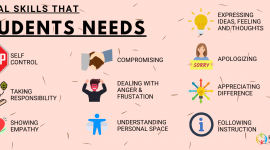In today’s digital world, every institution is facing the pressure to keep up with technological advancements which is not possible without digitizing the education process.
These days, it is not just classrooms that rely on technology to assist effective teaching and learning. Digital boards (or electronic whiteboards—EWB) have become increasingly popular in recent years among schools and educational institutions in more ways than one.
How have Digital Classrooms transformed the way of Learning ,the use of digital boards in classroom environments has increased beyond expectations in the past decade. Are you curious about the reasons behind this surge of popularity in using up-to-date tech tools such as digital whiteboard solutions? If so, then you have come to the right place.
Here, we will discuss a few top reasons why education facilities across the world are choosing digital boards for their classroom setups.
While in the past, students were taught using the good-old blackboards, teachers and professors have gone digital today. Today education is a process that has become more and more democratic, and the availability of information has been a real boost to facilitate learning entertainingly.
How does a digital board work?

A digital board is a large interactive whiteboard that can be used for displaying information, images, videos, and other multimedia content. It allows teachers to control what is displayed on the board from a computer or mobile device.
As per research conducted by boarding schools in Dehradun ,Digital boards are often used in classrooms to enhance the learning experience for students by making it more fun and engaging. It is used for teaching subjects such as math, science and art. Digital boards can also be used to display information about upcoming events or daily schedules in schools.
They can be used in classrooms to make lessons more interactive, engaging and dynamic. They also allow teachers to present materials in real time and receive feedback from students. Additionally, teachers save time by not having to erase the board or write on it with chalk every time they want to change something.
Digital boards are made up of two main components:
The electronic component– It includes the hardware that powers the digital board (such as a projector) and its software which allows users to control what appears on the screen.
The touch-sensitive surface– This is similar to an ordinary whiteboard and has sensors embedded underneath. It can sense when someone touches it with their finger or stylus pen.
Benefits of Digital Board over traditional boards
To foster a collaborative learning environment.
The digital board has become an integral part of the classroom and is used to promote collaborative learning. The use of the digital board has given students a way to interact with the teacher and their classmates in a more fun way. It also provides a forum to share their thoughts and ideas while working on projects.
Digital boards allow students to participate more actively in class discussions. Instead of just listening to the teacher speak, they can respond to prompts, ask questions, and interact with each other. It means that digital boards can help foster a collaborative learning environment where students feel comfortable asking questions and speaking up in class.
To improve the efficiency and flexibility of teaching methods –
The biggest benefit of digital boards is that they can help improve the efficiency and flexibility of teaching methods. Digital boards allow teachers to display visual content in an intuitive way, which can help them explain concepts more clearly and effectively. They also make it easier for students to follow along and understand the course material. It is a minimal effort and time-saver teaching method.
With digital boards, teachers no longer need to spend time taking notes during lectures as everything is already displayed on the board for all students to see at once. In addition, it also saves time for students who do not have to take notes during class since they can refer back to what was displayed on the board during class time instead.
To facilitate cellular-based learning.
Digital boards are becoming a popular way to interact with students in the classroom. Educators are using it for a variety of reasons- including to facilitate cellular-based learning, improve collaboration and enhance student engagement.
Teaching multiple users at the same time
Digital boards provide an opportunity for teachers to interact with multiple students at once and ensure everyone is on the same page. Teachers can use these devices to ensure students are learning and reviewing concepts from previous lessons. These tools are also great for group projects since every student can see everyone’s work and collaborate easily.
Interactive teaching- Enhanced learning experience, increased engagement
Digital boards also help teachers keep up with the latest trends in education technology by offering a wide range of educational apps that can be accessed through an internet or wireless connection. These apps allow users to access additional resources such as videos, quizzes, games and animations that enhance their learning experience.
Digital boards are also beneficial for students as they can be used to engage in hands-on learning activities and improve their understanding of course material. Students use digital boards to learn new software programs or develop creative writing skills.
Simultaneous access to a wide range of content
Digital boards are designed to help teachers and students access more content simultaneously. The use of digital boards allows them to take advantage of the available resources on the internet and display them on the board for easy viewing by everyone in the class.
Teachers and students can easily share their ideas and thoughts, making learning more interactive and engaging. It results in higher retention levels among students because they are exposed to multiple sources of information at once instead of just one source like a textbook or a lecture given by a professor or teacher.
Flexibility and Scalability
The use of digital displays in the classroom is becoming more and more prevalent. It is because students can access information at the click of a button, which makes learning more effective and efficient. In addition, there are many other benefits of using digital boards in the classroom.
- Through the cloud, data is shared easily and widely, creating an environment where students can work with each other, whether on the same campus or from remote locations connected via the internet.
- Access to Advanced Technology
Digital displays allow teachers to connect their lessons with technology, which is something that cannot be done with traditional chalkboards or whiteboards. It gives students access to advanced technology they would not otherwise have been exposed to. Digital displays also provide them with an opportunity to learn about computers and how they work at the same time while they are learning their lessons. Access to this technology will help them in their future careers when they enter the workplace.
Why are traditional boards still in use?
Digital boards can significantly reduce costs by eliminating the need for paper, pens, markers and erasers. It also reduces waste by not producing any paper products that can be recycled or reused. These devices are also easy to use and maintain which makes them cost-effective for students and teachers.
Traditional boards have been around for decades, but they are still used today because they are affordable and easy to use. However, digital boards have become more popular in recent years due to their convenience and efficiency.
Traditional boards are used in classrooms to keep students engaged and provide them with a place to write notes and doodles. But as technology advances, there is a shift towards digital boards because of their convenience and efficiency.
Conclusion
Educational institutions are adopting digital boards because they provide students and faculty with a contemporary way to teach and learn. Digital board technology is changing the way education is being imparted in modern classrooms.
It is no secret that the education industry is adopting new technologies at a rapid pace. The benefits of using digital boards in the classroom have been proven through research and anecdotal evidence. Digital boards are an easy way to engage students, increase student retention, and save time for teachers and other educators.
For any queries related to parenting, schooling, or any student-related tips, click here to check out our latest blogs.










